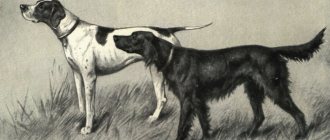When choosing your best dog friend, you need to take a serious look at the breeds and varieties, because the size, character and temperament of the animal depend on this characteristic.
For those who value nobility, speed and energy, the Weimaraner is the best option. A detailed and multifaceted description of the Weimaraner breed will help you make your choice.
Breed characteristics
| Short description | |
| Origin: | Germany |
| Conditions of detention: | House with garden |
| Purpose: | Companion dog, hunting dog |
| Color: | Silver gray, mouse gray, brownish gray |
| Wool length: | For short-haired dogs 1-2 cm, for long-haired dogs – 3-5 cm |
| Adult dog size: | The height of females is 57 - 65 cm, males 59 - 70 cm, weight of males is approximately 30 - 40 kg, females - 25-35 kg. |
| Average life expectancy: | 10-12 years |
| Walk: | Frequent long walks |
| Need for physical | High physical activity needs (regular or daily exercise for more than 3 hours per day) |
| Fédération Cynologique Internationale (FIC) classification: | Group 7 cops; Section 1 Continental Pointers |
| Puppy price: | From 20 to 60 thousand rubles. |
German dog
The majestic and noble Great Dane has a lean, slender build and huge, pointed ears. Its coat is usually caramel in color, except for its black muzzle, and it is quite large, ranging from 63.5 to 79.5 kg. When it comes to their eyes, things get a little more interesting. Great Dane puppies are often born with blue eyes , but their color usually changes to amber or brown as they mature. In rare cases, their eyes may remain blue.
Fun fact: In 2011, a Great Dane from Otsego, Michigan named Zeus was listed in the Guinness Book of World Records as the "Tallest Dog in History", standing at 111.8 cm tall and weighing over 70 kg (while standing on his hind legs , he had a height of 220 cm). It is reported that Zeus ate a kilogram of dog food every day. He passed away in 2014 when he was 5 years old.
History of the origin of the species
The origin of the Weimar cop goes back to ancient times. There are many legends about the origin of these dogs. The main reason is that King Louis IX of France, after his captivity in Egypt, brought with him a pack of gray dogs, the ancestors of the Weimaraner. Soon the nobility liked them.
The dogs were nicknamed “silver ghosts” for the incredible speed they developed while hunting. In addition to their professional mission - driving animals, Weimar cops became companions, accompanying wealthy people to receptions.
The breed received its name in honor of the German city in which it was bred . The official date of its appearance is considered to be 1896, when these dogs were first presented at the exhibition. The breed standard was established in 1925, but official recognition occurred only in 1944.
In the 50s of the 20th century in the United States, Weimaraners experienced a peak in popularity and became the favorite breed of President Dwight Eisenhower.
Labrador Retriever
The Labrador Retriever is consistently considered one of the most popular dog breeds – and for good reason. They have a naturally sweet and loyal disposition, are easy to train , and are known as one of the smartest dog breeds. This breed comes in three main colors: golden, chocolate and black. Like many of the breeds on this list, they most often have brown or amber eyes. Sometimes - often when mixed with other breeds - chocolate or black dogs with blue eyes may appear in this family.
Did you know that Labradors are actually native to Newfoundland and not Labrador, after which they were named. This water dog was originally used to catch ducks and help fishermen.
Distinctive features
The main characteristics of the Weimaraner's appearance are clearly stated in the breed standard:
- The head is small with a round nape. The muzzle is long, almost rectangular. The transition of the forehead to the bridge of the nose is not too obvious. The forehead is wide with a furrow where folds appear during concentration. Lips are pursed.
- The jaws are strong with strong white teeth. Scissor bite.
- The nose is large and classically shaped. The lobe is dark flesh color.
- The eyes are medium size, round. Oblique incision. Puppies' eye color is azure; in adults - amber.
- The ears are quite large and hanging. When alert, slightly turned forward.
- The tail is set low and covered with hair. At rest it is located below, in work it is horizontal and above.
- The paws are long and dry. The muscles are well defined.
- The body is sinewy and muscular. The ideal length to height ratio is 12:11. The chest is massive, but narrow, the back is straight. The stomach is tucked.
As for wool, there are two types of breed:
- Short-haired with close-lying hair without undercoat.
- Long-haired with soft wavy hair 3-5 cm long. The hair on the head is shorter, but the ears are decorated with a beautiful long fringe. On the tail there is a pendant in the form of a flag. There is practically no undercoat.
There are only 3 acceptable colors in the breed:
- Silver gray;
- Mouse;
- Gray-brownish.
Only small white markings on the chest and toes are acceptable. Brown and red spots are considered defects.
Border Collie
This sweet and intelligent herding dog has a small to medium build and a long, weather-resistant double coat. Although brown eyes are most common in this breed, some Border Collies have blue eyes. They may also have what is called heterochromia (Latin for “different colors”). In congenital heterochromia of the iris, one eye may be entirely blue or have different areas of pigmentation, such as brown and blue areas.
Fun fact: Border Collies often top lists of the smartest dogs in the world. They are also one of the fastest breeds in the world, reaching speeds of up to 48 km/h.
Photo of an adult dog
German Shepherd
This large dog breed has a majestic and sophisticated appearance and is also known for its intelligence and intelligence. This is one of the reasons why German Shepherds are an excellent breed for police and military units and why they have a reputation as loyal guard dogs . Their athletic physique and fearlessness also help in their challenging work! Although blue eyes are quite rare for German Shepherds, it can sometimes occur due to genetic variation.
IMPORTANT! Although German Shepherds are capable of adapting to a variety of living situations, their high energy and large size make them more suitable for homes with a large fenced yard. German Shepherds can do well in apartments as long as they get enough exercise every day.
Based on materials from: www.rd.com
Photos of puppies
Health
The Weimar Pointer can live about 10-13 years. But in order for the pet to live to this age, being beautiful and healthy, the owner must periodically show it to the veterinarian for a preventive examination and tests. It is also necessary to vaccinate the dog and carry out treatment against parasites and deworming.
In order to detect the disease in time, you need to know what health problems the Weimaraner breed is predisposed to:
- Demodicosis is an invasive disease caused by a microscopic mite.
- Bloating - intestinal volvulus occurs due to improper nutrition; a dog can die from bloating within a few hours.
- Cryptorchidism - occurs in male dogs, the pathology leads to infertility.
- Mastocytoma is a cancer cell disease.
- Hip dysplasia - can lead to immobility and causes severe pain to the dog.
- Myasthenia gravis is a disorder of neuromuscular transmission, most often observed in adult animals after one year.
- Pododermatitis is interdigital dermatitis.
- Entropion - entropion of the eyelid cannot be treated and requires surgical intervention.
- Corneal dystrophy is a group of non-inflammatory hereditary diseases that reduce the transparency of the cornea of the eye.
- Degenerative myelopathy is a severe progressive neurodegenerative disease that leads to paralysis of the hind limbs.
- Fibrosarcoma is a malignant tumor that develops from cutaneous or subcutaneous fibroblasts.
Longhaired Weimaraner
Feeding
When composing your pet’s diet, take into account its level of activity and activities. If the dog is hunting, it will need a higher calorie diet.
Calculation of portions depends on the age, weight, and health status of the animal. For dry food, manufacturers set recommended portions. As for natural food, 1 kg per day is enough for puppies, 2 or 2.5 kg per day for an adult dog. The daily norm is divided by the number of feedings, depending on age.
Dry food should be chosen super-premium or holistic.
The basis of natural nutrition should be meat and meat products - 50%. The remaining half should consist of cereals, vegetables, dairy products, and eggs.
Prohibited:
- tubular bones;
- chocolate and sweets;
- raisins and grapes;
- onion and garlic.
- wheat, corn, soybeans;
- White rice.
Photo: pixabay.com
Features of character and behavior
The Weimaraner is a kind, friendly dog. Representatives of this breed are fast and agile. But the character of each breed has its own pros and cons.
Advantages
- The first thing that distinguishes these dogs is selfless devotion and love for their owner. They are ready to follow him always and everywhere.
- If the owner is involved in hunting or sports , his pet will keep company in these activities.
- Weimar Cops are well suited for families with children. They patiently endure the pranks of little ones and enjoy playing with older children.
- These dogs get along quite easily with other animals . Although sometimes owners say that problems arose in the neighborhood with a cat or small rodents. Weimaraners have a highly developed prey instinct, which can awaken at any time, even if its working qualities are not used for hunting.
- When meeting unfamiliar people or animals, they behave warily, but not aggressively . Cops usually play friendly with familiar neighborhood dogs.
- Weimaraners are very intelligent and quick-witted dogs. They can easily be taught household tricks, for example, wiping their paws after entering the house. But there is a danger here - learning to open doors and latches will not be difficult for them.
Flaws
- If you don’t keep your pet busy with physical activity and games, then his cheerful disposition can take its toll on the home environment.
- Without proper socialization and training, the Weimaraner can develop into a problematic hyperactive dog.
- Despite his wary attitude towards strangers, he is not a watchman. At best, he will notify the arrival of a stranger by barking.
Welsh Corgi Cardigan
The Cardigan Welsh Corgi has a similar build to the Dachshund, with a long body and short legs, although this herding breed is slightly larger, ranging from 11.5 to 17.5 kg. Their coats come in a variety of colors, including red and blue merle, and their tail is long and bushy. According to the official Cardigan Welsh Corgi standard, "blue eyes in any coat color other than blue merle are disqualifying."
The cardigan’s wide “smile” is an outward manifestation of his friendly disposition . Affectionate and good-natured, the Cardigan Welsh Corgi gets along well with children, older people, other dogs and even cats.
Fun fact: According to Welsh legend, corgis are enchanted dogs chosen by elves and fairies to "draw their carriages and serve as steeds in battle," and the pattern on the corgi's back and shoulders are the marks of harness and saddle.
Care and maintenance
The first thing you need to think about when buying a Weimaraner puppy is whether you can provide him with comfortable living conditions. This is an active dog of impressive size, and it will be cramped in a standard apartment.
Dogs of this breed, regardless of the length of their coat, have virtually no undercoat; it is strictly forbidden to keep them outdoors. Only an insulated room is considered suitable living conditions for a Weimaraner!
The only possible option is a house with a decent area and preferably a garden where the dog can frolic. Lack of activity and exercise will negatively affect the development and health of your pet.
For winter walks, you must purchase insulated clothing, otherwise a long walk may result in colds.
Daily care for a dog of this breed is not burdensome:
- clean eyes, teeth and ears as needed;
- claws, if they do not grind down on their own, should be trimmed once every 3-4 weeks;
- bathe once every few months if there is severe contamination.
Nutrition
The issue of proper nutrition for a pet of this breed is extremely important, since Weimar pointers are prone to food allergies and problems with intestinal function.
In puppies, from 1-1.5 months there is a transition from milk to food. The number of feedings at this time and up to 3 months is 6-7 times a day . Then there is a gradual reduction in food intake. By the end of the dog's first year of life, you need to switch to two meals a day.
You can feed your Weimaraner dry food or natural food. In any case, the dog’s diet should be complete and balanced. When choosing food, owners should give preference to high-quality, high-quality food with a good composition.
When choosing natural feeding, you should exclude a number of products from the animal’s diet:
- fatty and fried;
- sweet and flour;
- spices and smoked meats;
- thin and tubular bones;
- minced meat, especially pork;
- river fish;
- onions and grapes.
Healthy foods that veterinarians recommend including in your dog’s diet:
- lean dietary meat;
- poultry meat, if there is no allergic reaction to it;
- dairy products;
- heat-treated sea fish without bones;
- vegetables and fruits;
- cereals
Any type of nutrition requires the dog to have constant access to fresh, clean water. Veterinarians also advise taking a course of vitamins 1-2 times a year , especially with natural feeding.
For working dogs, food should not be too cold or hot, only at room temperature. Otherwise, you can kill their sense of smell.
Health
Weimar cops are characterized by good health . However, this does not negate preventive visits to the doctor and close attention to the pet’s condition.
Vaccinations
Dogs must be vaccinated on time. The first vaccination is given to puppies at 6-8 weeks , then at 12 weeks - revaccination. Next comes a comprehensive vaccine at 6-7 after changing teeth . At 12 months , the dog will receive the third set of vaccinations and a mandatory rabies vaccine.
Vaccination is done against plague, adenovirus, parainfluenza, enteritis, hepatitis, leptospirosis.
The choice of medications is now very wide (Biovac, Nobivak, Kanigen, Eurikan). The cost of one vaccination can vary from 200 to 2,500 rubles . Therefore, when choosing a product, it is better to consult with a veterinarian, who will tell you about the advantages and disadvantages of each of them and advise the best option for your Weimaraner pet.
To successfully complete the vaccination procedure:
- the dog must be absolutely healthy;
- the period of teeth change must end or not yet begin;
- External and internal parasites must be treated 10-14 days before vaccination.
Vaccination is prohibited if:
- 2 weeks left before giving birth, or the dog gave birth less than 2 weeks ago;
- the pet is recovering from a course of antibiotics;
- there is a postoperative period.
After vaccination, the dog may be lethargic for a couple of days - no need to worry, this is normal.
For the next 2 weeks, the owner must limit the pet’s physical activity and not take it out into large crowds of other animals. The dog's immune system will be weakened for some time after the vaccine.
Diseases
Each breed, no matter how healthy it is, has identified the diseases to which it is most susceptible. The Weimar cop has this:
- Pathology of joints . It can be either hereditary or acquired. If the disease is detected in a timely manner, its course can be stopped.
- Pathology of the spinal cord . Can lead to complete paralysis of the animal.
- Myasthenia gravis . A disease in which a dog loses control over muscle activity.
- Eye diseases. Weimaraners are susceptible to deformation of eyelashes, entropion of the eyelid, inflammation and atrophy of the cornea.
- Problems with the stomach and intestines. Most often, bloating and volvulus occur as a result of improper feeding of the dog.
- Tumors. Melanoma, fibrosarcoma, mastocytoma - all of this occurs in Weimar cops in adulthood.
- Cryptorchidism. When choosing a male puppy, especially a mature one, you need to pay attention to whether both testicles have descended into the scrotum.
To prevent the appearance and development of these diseases, it is recommended to take your dog for examination to an experienced veterinarian at least once every six months.
Walk
These dogs are essentially pointers. They have a high need for daily long walks with physical activity. They need to be given the opportunity to expend their frantic energy and run out. In this case, there will be no problems with pets, and the dog will not want to play with the sofa leg or shoes.
Weimaraners should only go for walks accompanied by their owner. The hunting instinct can force a dog to chase a passing cat at any moment. In pursuit, the dog forgets itself and may not notice a car or other danger awaiting it.
The ideal option is to take your pet to the forest or to a playground with plenty of equipment to play with . Frisbees, balls, and any other objects that you can run after are welcome. The dog will be captivated by such activities for hours.
Grooming
Grooming both short-haired and long-haired Weimaraners does not take much time . They do not shed because there is almost no undercoat. Brush them once a week. Short-haired - with a rubber brush, long-haired - with a brush with short teeth.
Common diseases
The Weimaraner is not susceptible to common diseases. The main danger is hereditary diseases and problems related to anatomy. First of all, intestinal volvulus is common - similar problems are typical for dogs with deep chests. At the first symptoms of gastrointestinal distress, you should contact your veterinarian immediately.
It is recommended to buy feeders where the bowls are located at the level of the dog's head. This way your pet will stop swallowing food too actively. The air that causes volvulus will not enter the gastrointestinal tract.
Weimar cops are prone to the following diseases:
- Von Willebrand's disease (blood clotting disorder).
- Joint dysplasia, typical for large pets.
- Distichiasis is the appearance of a second row of eyelashes.
- Corneal atrophy and entropion.
- Skin problems - dermatoses.
- Oncological diseases.
Nervous disorders are possible. One of these is OCD, or obsessive-compulsive disorder. A sign of an anxious state is sucking on beds and bedding.
Mating
- For help in choosing a pair for your pet, it is better to contact experienced breeders. They will tell you what to look for when casting a future partner. The suitable age for mating an animal is from 1.5-2 years , not earlier. Bringing dogs over 7 years of age is strictly prohibited.
- Breeding Weimaraners has many pitfalls . For example, great care must be taken when crossing short-haired and long-haired varieties.
- At a kennel or dog club, professionals will tell you about all the difficulties of mating , pregnancy and childbirth, and will also help you go through these stages as painlessly as possible.
- It is better to introduce the dogs in advance on a neutral site, but mating takes place exclusively on the territory of the cable 11-14 days after the female starts estrus. After a day or two, a control mating is carried out to guarantee the result.
Dachshund
badger dog in German , is a small and energetic German dog breed with excellent hunting skills (hence its name). Today they are affectionately called "sausages" because of their resemblance to a hot dog: a long body with four short legs. Dachshunds can have long or short hair and typically have chocolate brown eyes. In very rare cases they may have blue eyes. Pay attention to other short-legged dogs that have a pretty appearance and a mischievous character.
IMPORTANT! Although dachshunds can be difficult to train, they are hunters at heart and love to work for reward. Practice with toys and treats for quick success. As with most hounds, the key to success is patience and consistency.
Key points in training
Weimaraners are very intelligent and quick-witted dogs. They are easy to train. The only difficulty the owner faces is stubbornness and attempts to dominate.
- Professionals advise conducting classes in a secluded place where nothing will distract the puppy from learning commands. Training is conducted in a playful manner without the use of physical force; a severe reprimand for disobedience is sufficient.
- You can organize training in pairs with an adult trained dog; the puppy will happily copy its behavior and remember commands more successfully.
- Read about how to properly train a dog in the article: “Training a puppy: effective methods from dog handlers, learning commands at home.”
Beginner dog owners are advised to take the course under the supervision of a professional instructor. When training a Weimaraner, patience, firmness and perseverance of the owner are important.
Bull Terrier
You'll easily recognize a Bull Terrier when you see one! It is a distinguished and unusual-looking dog with an ovoid head , a wide and rounded muzzle, pointed ears and a medium-sized muscular body. Its triangular eyes are often dark brown, but on very rare occasions you may see this white dog with blue eyes. This is more common when crossing a Bull Terrier with a Merle dog.
Fun fact: Bull Terriers were first bred in the 1830s as fighting dogs, likely by crossing the Bulldog with the now extinct White English Terriers and Dalmatians to increase their size. Bull Terriers were considered gladiators in the dog fighting ring and were valued for their strength and tenacity.
How to choose a puppy
The breed is not very common in Russia, so there are practically no advertisements for the sale of puppies by hand. It is better to purchase a baby from a trusted nursery, which will give a guarantee of quality, show the pedigree, parents and offer several puppies to choose from.
There is no need to rush when buying . Meeting your future pet is a very exciting moment. You can observe how he behaves with other puppies, how he reacts to a new person. It is recommended to carefully examine the baby for the absence of obvious external defects.
- Show class puppies are the first in the litter and are intended for exhibition. Such puppies usually cost more than 30,000 rubles .
- Pet-class babies have no defects, but are considered slightly lower in quality and are sold as pets. Their cost starts from 20,000 rubles.
The final cost depends on the title of the kennel and the richness of the puppy’s pedigree.
But do not forget that not only heredity affects the development of a dog! Its further nutrition, maintenance and growth conditions for the pet are important.
Weimar Pointers are an elite breed of dog that combines keen intelligence, friendly qualities and hunting skills. It is suitable for outdoor enthusiasts, novice dog owners and families with children. But homebodies with limited living space should avoid choosing a Weimaraner puppy.
5 / 5 ( 1 voice )
Siberian Husky
Known for its thick coat, high energy and stamina, the Siberian Husky is one of the most popular dog breeds with blue eyes. They are pack dogs , meaning they love to spend time with other dogs. They also need plenty of space to run around and burn off excess energy, so a large yard is a must. The appearance of Siberian Huskies is striking not only with their bright blue eyes, but also with their sharply contrasting white, gray and black fur.
IMPORTANT! These mischievous, agile dogs need an active owner who can keep them in good shape. They also like to dig holes, as their arctic ancestors dug into snow to build protective burrows and hide food.
American Pit Bull Terrier
Some types of pit bulls are known for their beautiful blue eyes. Blue-eyed pit bulls, although not very common, are very popular throughout the world. The colors include mixtures of brown, yellow and even green eye colors. There are even pit bulls with two different colored eyes. Unfortunately, blue eyes are considered a flaw in the standards. As a result, any blue eyed pit bull is disqualified from showing.
Varieties
There are three breed varieties that you should know about before purchasing a Weimaraner. All of them differ only in color or long fur. The remaining data (appearance and character) do not change.
Basically, there are individuals with hard and short hair, which is smooth to the touch. Another variety boasts long and soft hair - from three to five centimeters. It is less common to find straight-haired dogs. They have a two-layer coat with a thick undercoat and an upper, absolutely smooth, layer of medium length.
Some kennels may offer "blue Weimaraners". These dogs have gray-blue fur and black lips and nose. These are wonderful animals that are best suited to be a family friend, but they cannot take part in exhibitions. Therefore, you can buy a “blue Weimaraner” puppy cheaper than a “regular” one.











